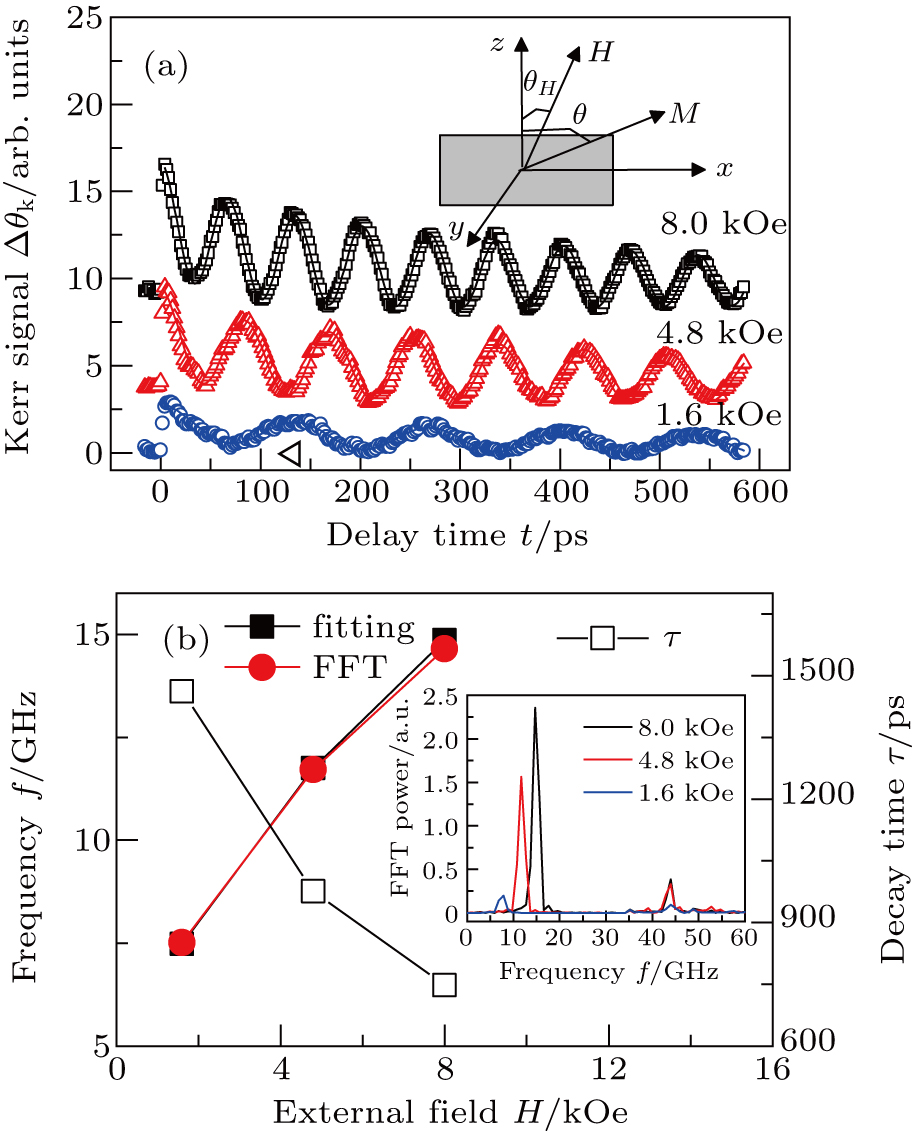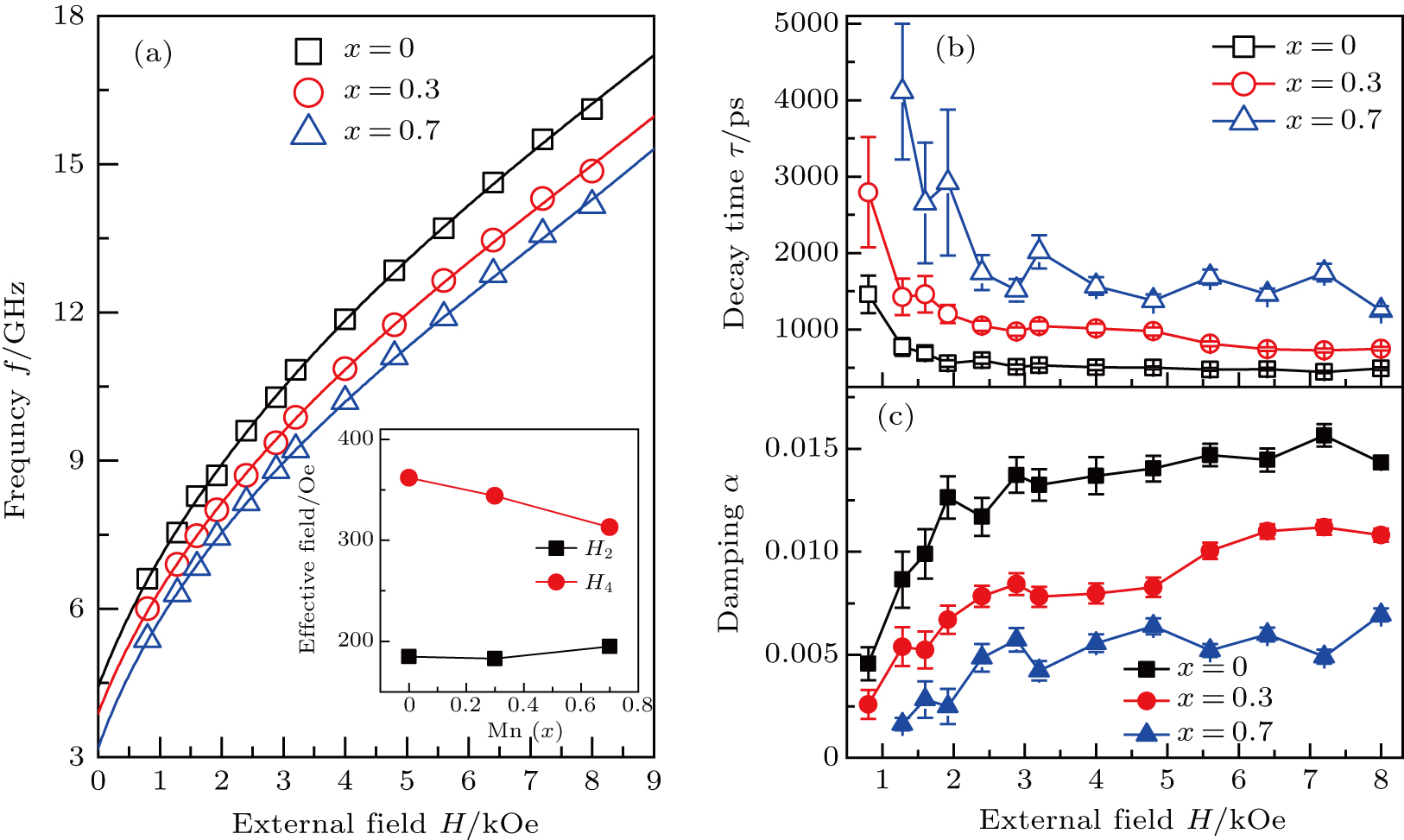† Corresponding author. E-mail:
Uniform precession dynamics and its magnetic damping are investigated in epitaxial Co2Fe1−xMnxAl films by using the time-resolved magneto–optical Kerr effect under out-of-plane configuration. The decay time of uniform precession mode decreases, and thus the magnetic damping increases with the increase of external field. Moreover, the decay time decreases as x decreases, so that the enhancement of magnetic damping occurs in Fe-rich sample. Furthermore, the decay time decreases as the excitation fluence increases, which drops rapidly at low magnetic field comparing with the slow reduction at high magnetic field. This unique magnetic damping enhancement is attributed to the enhancement of homogeneous magnetization.
The magnetic relaxation of ultrafast magnetization dynamics in ferromagnetic films is a challenging subject for engineering the ultrafast magnetic processes in magnetic information storage and spintronic applications, which can be triggered by magnetic field pulses, femtosecond laser pulses, or spin-polarized currents.[1–5] As a half metal, cobalt-based full-Heusler ferromagnetic alloy film is the promising material for spintronics,[6–8] owing to their high spin polarization and Curie temperature, and the existence of multiple spin-wave modes.[9,10] Moreover, such alloy normally presents low Gilbert damping,[11] which is a key parameter for transporting, storing, and processing information in magnonics. Therefore, understanding and controlling the magnetic damping in Heusler alloys becomes crucial importance. Up to now, its behind mechanism is still controversial. The extrinsic uniform precession mode in Heusler alloys is normally attributed to the mechanism of inhomogeneous magnetization.[12–14] In Co2FeAl film, this inhomogeneity can only explain the magnetic damping in the low-field regime, but fails to explain the damping of the high-field regime.[15] In addition, multiple spin wave modes typically exist in Heusler alloys,[16–19] and then the two-magnon scattering should be the dominant origin. For example, the two-magnon scattering attributes to the damping in Co2FeSi Heusler alloys,[20] and induces extrinsic magnetic damping for half-metals at low magnetic field.[21,22] Recently, in half metal Fe3O4 films,[23] the population of the perpendicular standing spin wave (PSSW) mode increases the magnetic damping of uniform precession mode with the increase of external field, and acts as an additional channel for the dissipation of uniform precession mode. However, in many Co-based Heusler alloy films,[12–15,21] the magnetic damping of uniform precession mode normally decreases with the increase of external field, and does not transfer its energy to the PSSW mode, although we should observe the uniform precession mode and PSSW mode simultaneously.
To explore the magnetic damping behaviors of Heusler alloys and get insight to its behind mechanism, we investigate the uniform precession dynamics in the thinner Co2Fe1−xMnxAl films epitaxially grown on GaAs (001) substrate with the time-resolved magneto–optical Kerr effect under out-of-plane configuration. Surprisingly, the decay time of uniform precession mode decreases with the increase of external magnetic field, so that the enhancement of external field-dependent magnetic damping is observed. In addition, the decay time decreases and then its magnetic damping increases as x decreases. Furthermore, the decay time decreases with the increase of excitation fluence, and it reduces rapidly at the low-field regime comparing with the slow drop at the high-field regime. This unique magnetic damping enhancement in Co2Fe1−xMnxAl films is attributed to the enhancement of homogeneous magnetization, but not the inhomogeneous magnetization.
The Heusler alloy films Co2Fe1−xMnxAl (x = 0, 0.3 and 0.7) studied here were deposited on a GaAs (001) substrate using molecular beam epitaxial at a temperature of 280 °C. The thickness of the deposited film was set to 10 nm, and these films were capped with a 2-nm aluminum in order to prevent oxidation. All the three elements Co, Fe, and Mn show ferromagnetic states and contribute ferromagnetism to the film with the help of x-ray magnetic circular dichroism measurement. The magnetic measurement with a superconducting quantum interference device also represents the pure ferromagnetic property in these films, and further indicates the coexistence of in-plane uniaxial and fourfold magnetic anisotropies. More details on the preparation and magnetic properties of the sample were shown in Ref. [24].
Ultrafast magnetization dynamics was measured by using a time-resolved magneto–optical polar Kerr (TR-MOKE) configuration. The femtosecond laser pulse from a Ti:sapphire regenerative amplifier is linearly polarized, and has a maximum energy of 0.5 mJ per pulse with a duration of 150 fs at the central wavelength of 800 nm. The laser pulse with a repetition rate of 1 kHz is split into a stronger pump pulse and a weaker probe pulse with their fluence ratio larger than 30. The two pulses are incident almost perpendicularly and focused on the surface of the sample. The diameter of focused pump spot is approximately 

The pump-induced magnetization dynamics of Co2Fe0.7Mn0.3Al film (x=0.3) with a constant fluence of 
 |


The frequency of the precession dynamics for the Co2Fe1−xMnxAl films was plotted in Fig.
 |











The relaxation rate of dissipating magnetization dynamics can be represented with the parameter of Gilbert damping, which is critical for engineering the magnetization dynamics involving ultrafast magnetic processes in future magnetic applications, and will be studied in the following. Figure
The Gilbert damping α and the decay time τ are related by the following function:[28]
 |
We further measure the excitation fluence-dependent precession dynamics of Co2Fe1−xMnxAl films under a constant magnetic field. Figure
The magnetic damping observed in our experiment significantly differs from the results reported in many Heusler alloys,[12–14] which is dominant by the mechanism of inhomogeneous magnetization. In contrast, it is consistent with the increased magnetic damping observed in Fe3O4 films due to the enhancement of homogenous magnetization.[23] As reported, the homogeneous magnetization facilitates the excitation of spin wave mode,[27] and then the uniform precession mode can transfer its energy to the spin wave mode.[23] In the low-field regime, the inhomogeneity dominated by the competition between H2 and H4 hinders the energy transfer from uniform precession mode to spin wave mode, leading to the small magnetic damping. In the high-field regime, this transfer increases since the magnetization precession becomes more uniform owing to the neglecting magnetic anisotropy effective field compared to external field, so that the magnetic damping increases. Therefore, the magnetic damping increases with magnetic field as the inhomogeneity of sample changes to homogeneity. As x decreases, the competition between H2 and H4 becomes weak due to the larger H4,[29] leading to the enhancement of homogeneity of sample. So that, the magnetization precession becomes more uniform, which thus causes the increased magnetic damping. Meanwhile, as the excitation fluence increases, the magnetic anisotropy effective field decreases owing to the heating, and thus the magnetization of sample becomes more uniform. This process occurs significantly at low magnetic field, so that more energy dissipates from the uniform precession mode to the spin wave mode, leading to more rapid increase of the magnetic damping. We therefore indicate that the increased magnetic damping of uniform precession mode in 10-nm Co2Fe1−xMnxAl films is attributed to the enhancement of homogeneous magnetization, but not the inhomogeneous magnetization. In 10-nm Co2Fe1−xMnxAl films, the PSSW mode can be excited and acts as an additional channel for the energy relaxation of uniform precession mode. So that one possible origin of such increased magnetic damping could be the energy transfer from uniform precession mode to PSSW mode. The frequency of this PSSW mode is huge, on the order of 250 GHz, due to the inverse relationship of square of the thickness.[16,27] It is difficult to detect this huge-frequency PSSW mode in our experiment because of the very small period and very fast decay. Therefore, in future, more experiments are needed to study the characteristics of this increased magnetic damping in uniform precession mode, and then to deeply understand the behind mechanism.
In conclusion, the unique magnetic damping enhancement of uniform precession mode was observed in 10-nm epitaxial Co2Fe1−xMnxAl films by using the time-resolved magneto–optical Kerr effect under out-of-plane configuration. The magnetic damping increases with the increase of external magnetic field, which increases rapidly at low magnetic field comparing with that at high magnetic field. In addition, the magnetic damping increases as x decreases due to the weaker competition between in-plane uniaxial and fourfold magnetic anisotropy. Moreover, the excitation fluence-dependent magnetic damping shows the rapid reduced decay time at low magnetic field than the one at high magnetic field. These therefore indicate that the increased magnetic damping of uniform precession mode in 10-nm Co2Fe1−xMnxAl films is attributed to the enhancement of homogeneous magnetization, but not the mechanism of inhomogeneous magnetization. These observations enrich the magnetic damping property for Heusler alloy films, although its origin remains subject of speculation. However, its future understanding could enable the magnetization characteristics of Heusler alloy films to the needs of the given application.
| 1 | |
| 2 | |
| 3 | |
| 4 | |
| 5 | |
| 6 | |
| 7 | |
| 8 | |
| 9 | |
| 10 | |
| 11 | |
| 12 | |
| 13 | |
| 14 | |
| 15 | |
| 16 | |
| 17 | |
| 18 | |
| 19 | |
| 20 | |
| 21 | |
| 22 | |
| 23 | |
| 24 | |
| 25 | |
| 26 | |
| 27 | |
| 28 | |
| 29 |





